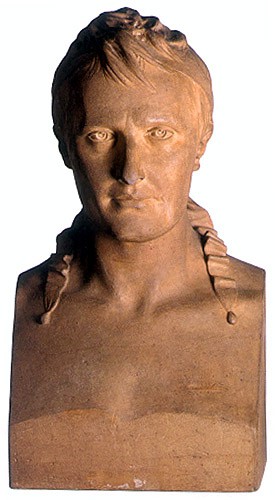As a remarkable portraitist who had immortalised the great men of the 18th century, Jean-Antoine Houdon was commissioned during the Empire period to make a monumental bronze statue of Napoleon, designed to go on top of the Grande Armée column in Boulogne – the reliefs at the base of the column were to be executed by Jean Guillaume Moitte. And in 1806 Napoleon agreed to sit for Houdon in the Palais de Saint-Cloud: “[…] H. M. the emperor deigned to sit for me for the making of his bust. I was very pleased that he was happy with the likeness”. The bust was done in terracotta, and as a result of the exceedingly precious sitting time, remains probably one of the finest representations of the emperor ever made. Simplicity, sobriety, and severity all emanate from this psychologically profound work, a profundity which derives from the sculptor's extraordinary powers of observation. This representation, in the form of a herm, portrays the emperor as if he were an ancient Caesar or a Greek statesman, firmly the tradition of the rediscovery of antiquity in the Neoclassical style.
The bust was first displayed to the public at the Salon of 1806 with an inscription in old-fashioned French cut into its left side: «His majesty / Emperor and King/ taken from life/ St Cloud August 1806 / Houdon f.[ecit]» As a result of the success of this work, Houdon was to receive two further commissions, namely busts in marble of the emperor and empress. The Journal de la Revue philosophique was to review Houdon's sculpture of the emperor in the following way: “the bust of the emperor is the best likeness I know: it is nature, it is life”. Indeed, by using his trademark technique of incising the pupils, the artist gave a remarkable rendition of the intelligent look and the intensity of expression. Two centuries later, this sculpture still works its strange magic.
As for the bronze statue for the top of the Grande Armée column in Boulogne, the cause of the masterpiece here, it was completed in 1813 but never mounted. The column was not finished until 1821, but by then the five-metre tall statue of the emperor in imperial costume had been melted down to provide the bronze for an equestrian statue of Henry IV by Lemot which was installed on the Pont Neuf in 1818.
Karine Huguenaud (tr. P.H.)
March 2004
Bust of Napoleon I
Artist(s) : HOUDON Jean-Antoine

- Date :
- 1806
- Technique :
- Terracotta
- Dimensions :
- H = 52.5 cm, L = 26 cm, P = 20.5 cm
- Place held :
- Dijon, Musée des Beaux-Arts
- Photo credit :
- © musée des Beaux-Arts, Dijon

